- Created By: Site Admin
- Created: March 17, 2023 11:59 pm
- Updated: March 18, 2023 12:01 am

Considered Arcata’s best example of Greek Revival architecture, the Phillips House was placed on the National Register of Historic Places in 1985. Deep cornice returns, divided frieze band, matching front and rear porches set beneath the roofline, central entrances and square porch posts provide the classic detail on this one-and-a-half story, side-gabled house. Typical of early settlement houses are the 6/6 windows and clapboard siding. This little house appears to have been built in 1852, which qualifies it as Arcata’s oldest, architecturally-intact house. William Phillips, a Massachusetts blacksmith, came to Humboldt Bay in 1851 and made a claim to the swamp and overflow land below the hill where he built this house. He ran cattle on the upland areas, an enterprise carried on by subsequent owners, B.M. Stokes and Mel Roberts who had dairy operations on this farm; even today, cattle still graze on portions of that original claim. The house is owned by the City of Arcata, but leased to the Historical Sites Society of Arcata and used as a museum.

Considered Arcata’s best example of Greek Revival architecture, the Phillips House was placed on the National Register of Historic Places in 1985. Deep cornice returns, divided frieze band, matching front and rear porches set beneath the roofline, central entrances and square porch posts provide the classic detail on this one-and-a-half story, side-gabled house. Typical of early settlement houses are the 6/6 windows and clapboard siding. This little house appears to have been built in 1852, which qualifies it as Arcata’s oldest, architecturally-intact house. William Phillips, a Massachusetts blacksmith, came to Humboldt Bay in 1851 and made a claim to the swamp and overflow land below the hill where he built this house. He ran cattle on the upland areas, an enterprise carried on by subsequent owners, B.M. Stokes and Mel Roberts who had dairy operations on this farm; even today, cattle still graze on portions of that original claim. The house is owned by the City of Arcata, but leased to the Historical Sites Society of Arcata and used as a museum.
